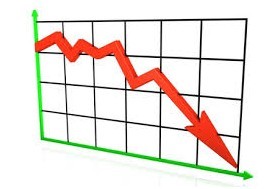
How to stop grieving over 2008 financial crisis
USINFO | 2013-11-14 14:13

While the collapse of Lehman Brothers was the biggest event in an 18-month market meltdown that saw the Dow Jones Industrial Average cut in half, Hugh says his family’s investment portfolio dropped by closer to 66% during the crisis.
“I took chances,” he said by phone, “and I was way up before the crisis, then we lost a lot, but I think the same kinds of risks would have helped me recover by now…I certainly would be a lot closer to where I was at the peak, but [Ines] is just not able to get over what happened and I don’t want to upset her, so it’s making it hard to invest.”
Ines, meanwhile, clearly is like a lot of investors: She’s still grieving the loss she suffered just as her account balance seemed so close to reaching lifelong goals—targets that five years later feel like they may never be reached, even as the stock market has recovered to reach new record highs.
It’s a situation that a lot of investors can learn from, because Hugh represents the side of investors that wants to take risks and Ines the piece that is risk-averse.
Ultimately, however, all investors need to put the past, good or bad, behind them to focus on how to survive and profit from what’s next. What makes that hard is that, like Ines, many people are still in the five stages of grief and mourning, dealing with a past so traumatic that, emotionally, it’s like there was a death in the portfolio.
Experts in behavioral finance have long noted that investors internalize losses and take them far more personally than wins.
Those experiences create painful scars, especially when the wounds are as deep as 2008.
“With loss, people become emotionally scarred, and then look for reasons to make sure they avoid that pain again,” said Richard Peterson of MarketPsych Data, which studies investor behavior. “People were so angry, upset and mistrustful that they have discounted the good things, and they have missed out as a result.
“To win on Wall Street, you have to go against some very basic human emotions,” he added. “You have to invest when you think everyone on Wall Street is a scoundrel, when you think they are all wicked and you’re going to lose all your money. That’s hard to do at any time, but particularly when you have been so deeply scarred.”

For investors who have struggled emotionally with the market ever since the 2008 crisis, it’s important to get past those phases in order to get back on track to reaching goals and objectives.
Denial and isolation are normal reactions to rationalize overwhelming emotions, normally a first response to get through a temporary wave of pain. For investors like Hugh and Ines, this is where—in the middle of the meltdown—they wound up frozen by fear, not wanting to deal with the pain, repeatedly checking their portfolios with a mindset of “This isn’t happening.”
At a point when they might have been able to make moves that might have protected them from some of those oversized losses, this is why they were frozen.
Anger was the universal emotion over the 2008 crisis, but it also was a damaging emotion for investors, as it was often misplaced. Your favorite long-time mutual fund holding may have lost nearly 40% in 2008, but it didn’t cause the problem, and it’s not like the problem didn’t take down virtually every investment in nearly every asset class.
Moreover, investors Ines blamed the investment pros for her family’s oversized losses without being angry at Hugh for a highly aggressive asset-allocation that led to particularly egregious losses.
Bargaining is the “if only” stage. For investors, it’s “If only I hadn’t let my gains ride” or “If only I had changed to a more conservative allocation,” and so on. It’s where investors also start to regain control, where they acknowledge how much they hate the system but recognize that it’s the world they live in, and promise to take more control and do better next time.
The problem is that for all of those promises and deals, follow-through is hard.
Depression for many investors is still setting in, with the realization for many that the market has reached new record highs, but that their portfolio hasn’t recovered. For a risk-taker like Hugh, the new market peak made the losses more real than they had been when they were simply shrinking numbers in the middle of the panic; “that’s when I felt a real sense of loss, because most people had recovered and I hadn’t,” he said. For Ines, that’s “when it felt like we would never get back to where we were no matter what we did.”
As with so many of the grief emotions, the problem for investors is that this slows the process of doing the difficult thing, namely investing when market conditions have made it uncomfortable.
The acceptance stage is a part of the process that many people don’t get to; they can’t ever be calm about the market. Hugh feels this way about Ines, noting that “she went crazy about the Flash Crash, and then it was bankruptcy talk for Greece, and now it’s Syria, but it’s always something, and she doesn’t believe that these things are always happening on the market.”
Ultimately, investors who have spent the last five years buried in the emotions of financial loss need to move on, just as the market has.
Said Peterson: “Emotionally, nobody wants the market to get the better of them, but once they give in to these emotions, that’s typically what happens.…You shouldn’t forget what happened—or think that it can’t happen again—but if you’re still living in the events that happened five years ago, you’re never going to be able to be focused on what you have to do to make money now.”
Share this page



















